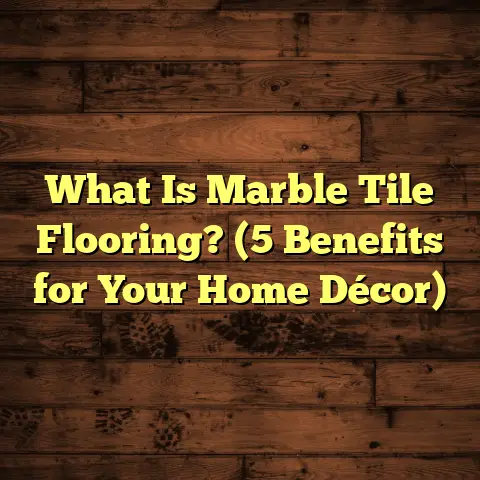What is Poured Flooring? (5 Key Benefits for Your Space)
Have you ever walked into a space and felt something instantly different under your feet? Maybe it’s that smooth, continuous feel that just makes the room seem more open, more modern, or somehow cleaner. What if I told you that this sensation comes from a type of flooring that’s poured as a liquid and forms one seamless surface? That’s poured flooring for you. If you’re curious about what poured flooring really is and why so many people—homeowners, business owners, and designers alike—are choosing it over traditional floors, stick with me. I’ll share what I’ve learned after years of installing, repairing, and researching this fascinating flooring option.
What is Poured Flooring?
Poured flooring is a broad term for floors created by spreading liquid materials over a surface and allowing them to harden into a durable, smooth layer. Unlike more traditional flooring types like hardwood planks, carpet, or tile, poured floors don’t have seams or joints. Instead, they form a continuous surface that can be custom-colored, textured, or finished in many ways.
When I first encountered poured flooring on a commercial project years ago, I was struck by how different it felt compared to other floors. No cracks, no grout lines—just a clean canvas beneath your feet. Since then, I’ve worked with various types of poured flooring such as:
- Epoxy Flooring: Made from resin and hardener chemically mixed to cure into a strong finish.
- Polyurethane Flooring: Similar to epoxy but typically more flexible and UV resistant.
- Polished Concrete: The existing concrete slab is ground and polished to create a smooth, shiny surface.
- Self-Leveling Cementitious Overlays: Cement-based liquids that level out uneven floors and can be pigmented.
How is Poured Flooring Made? The Technical Side
The manufacturing and installation process varies depending on the material chosen. Let me explain the epoxy process in detail as it’s one of the most popular poured floor types I’ve installed.
- Subfloor Preparation
This is arguably the most important step for a successful poured floor. The existing surface must be clean, dry, and free of contaminants like oil or dust. Sometimes grinders or shot blasters are used to roughen the surface for better adhesion. - Primer Application
A primer layer is applied to seal the subfloor and enhance bonding between the substrate and epoxy layers. This also prevents bubbles from forming during curing. - Mixing Components
Epoxy flooring systems come in two parts: resin and hardener. When mixed, they undergo a polymerization reaction that transforms the liquid into a solid plastic-like material. - Pouring and Spreading
Once mixed thoroughly (following precise ratios), the epoxy is poured onto the floor and spread evenly using trowels or rollers. Because epoxy starts curing quickly—often within minutes—installers work fast to avoid uneven surfaces or air bubbles. - Curing Period
The floor needs time to cure fully. Depending on temperature and product specs, this can range from 24 hours before light foot traffic to several days for heavy use. - Optional Topcoat
For added durability or gloss, a clear polyurethane or epoxy topcoat may be applied once the base layer cures.
For other poured floor types like polyurethane or cementitious overlays, the process is similar but with differences in chemical composition and curing times.
What Makes Poured Flooring Unique?
What stands out about poured floors is their versatility and endless customization options. You can mix colors right into the material or add metallic powders for swirling effects. You can embed chips or aggregates for slip resistance or texture. You can even create logos or patterns within the floor during installation.
Plus, because the floor cures as one piece, it’s incredibly strong and resistant to common problems like cracking or lifting if installed correctly.
Why I Recommend Poured Flooring – 5 Key Benefits
Over time, after installing dozens of poured floors in homes, stores, galleries, warehouses—you name it—I’ve noticed five main reasons why people choose this flooring type again and again.
1. Seamless Surface with Incredible Design Freedom
Seams are often the weak link in flooring—they collect dirt, crack over time, and limit design options. Poured flooring eliminates that completely.
Imagine a living room floor that’s one uninterrupted sweep of color or pattern. Or an office lobby with metallic swirls that catch the light differently throughout the day.
A personal story: A couple I worked with wanted something different for their kitchen remodel but were tired of grout lines in tile collecting dirt. We chose self-leveling polyurethane with a custom sandy beige tint. The seamless floor not only made cleaning easy but also gave their kitchen a clean yet warm look that friends still compliment years later.
According to research by The Concrete Network, polished concrete (a type of poured floor) accounts for over 10% of commercial flooring installations in North America due to its smooth finish and design flexibility.
2. Exceptional Durability That Lasts
I can’t stress enough how tough these floors are. Epoxy poured floors handle heavy foot traffic, heavy loads, chemicals, even impact better than most traditional floors.
Here’s some data: Epoxy floors have compressive strengths around 8,000-10,000 psi—twice or triple that of regular concrete slabs. This means they resist dents and gouges from dropped tools or machinery.
In one industrial facility I worked on, the epoxy floor was exposed daily to oil spills and heavy forklift traffic. After 5 years, it still looked nearly new with just routine cleaning.
3. Maintenance Made Simple
One of my clients who runs a busy bakery told me how much easier cleaning became after switching from tile to epoxy floors. No grout lines meant no trapped flour or sticky spills.
Poured floors require minimal maintenance—usually just sweeping and mopping with mild detergents.
This ease impacts cost too: According to HomeAdvisor, epoxy floors reduce cleaning costs by about 25% compared to tile or hardwood over time due to their nonporous nature.
4. Fast Installation Means Less Downtime
Many people hesitate when considering new floors because they worry about how long their space will be out of commission.
With poured floors especially epoxy or polyurethane types—installation usually takes 2-3 days total including curing time.
I vividly remember an overnight installation at a retail store where we finished late Friday night and they reopened Saturday morning without any issues.
This speed is not just convenient but often critical for commercial spaces where downtime means lost revenue.
5. Environmentally Friendly Options Are Growing
Sustainability has become important to many homeowners and businesses I work with.
Fortunately poured flooring manufacturers respond by offering low-VOC (volatile organic compound) formulas that reduce harmful emissions during installation.
Polished concrete also fits eco-conscious projects by using what’s already there—the slab—without adding new materials.
In Portland recently I installed bio-based epoxy made partly from plant oils for a client who wanted both durability and reduced environmental impact.
Deeper Look: Technical Aspects That Impact Your Choice
I like sharing technical details because knowing them helps avoid surprises during installation or use. Here are some factors worth understanding:
Material Strength & Thickness
For epoxy-based poured floors:
- Thickness varies from 2 mm (thin coatings) to over 6 mm (heavy-duty industrial).
- Thicker layers increase durability but cost more.
- Compressive strength usually ranges from 7,000 to 10,000 psi.
- Tensile strength (resistance to pulling apart) averages around 1,200 psi.
Polyurethane tends to be slightly less strong but more flexible with better UV resistance (good for sunlight-exposed areas).
Polished concrete strength depends on original slab quality—typically between 3,000-5,000 psi—but polishing makes it denser and more wear-resistant.
Chemical Components & Curing
Epoxy resins combined with polyamine hardeners create cross-linked polymers during curing—this results in a rigid plastic-like surface.
Polyurethane uses different chemical chains that provide elasticity along with hardness.
Temperature plays a big role in curing times—warmer conditions speed up curing but can cause bubbling if too fast; too cold slows curing dramatically.
Slip Resistance & Safety
A potential downside of smooth poured floors is slipperiness when wet—especially for pure epoxy coatings.
To address this:
- Anti-slip additives like fine silica particles can be mixed in.
- Textured finishes can be applied.
- Matte topcoats reduce gloss which improves grip.
I always recommend discussing safety requirements for your space with your contractor before choosing your finish type.
Common Myths About Poured Flooring
Since poured flooring sounds somewhat “new,” I often hear misconceptions from clients which I want to clear up here:
Myth #1: Poured Floors Are Only Industrial
False! While poured floors started in warehouses and factories for durability reasons, they’ve now become hugely popular in homes and retail spaces due to style options.
I installed metallic epoxy floors in an art gallery last year—it looked more like a piece of art than industrial concrete.
Myth #2: They Are Too Expensive
Initial costs are higher than laminate or carpet but lower than high-end stone tiles when factoring in longevity and maintenance savings.
Many clients tell me they saved money over time since poured floors don’t need replacing every few years like hardwood or vinyl might.
Myth #3: Installation Is Messy & Complicated
While surface prep is critical (and sometimes dusty), actual pouring involves quick work but minimal mess compared to tile grouting or sanding wood floors.
Professional installers use protective gear and contain dust well nowadays.
Real-Life Examples & Case Studies
Here are some projects I want to share that highlight poured flooring advantages:
Case Study 1: Residential Kitchen Remodel
A client in Seattle wanted something unique yet practical for their kitchen island area where water spills were frequent.
We chose polyurethane poured flooring tinted light gray with embedded mica flakes for sparkle.
The seamless nature prevented water damage under cabinets common with tile grout.
After 3 years they reported zero cracks or stains despite heavy use from kids and pets.
Case Study 2: Commercial Auto Repair Shop
In Detroit I worked on a garage floor exposed daily to oil drips and heavy machinery wheels.
Epoxy poured flooring held up exceptionally well with easy cleanup procedures after every shift.
The shop owner noticed fewer slip incidents due to slip-resistant additives incorporated during installation too.
Case Study 3: Art Gallery Floor
A downtown New York gallery wanted something visually striking but durable under high visitor traffic.
We created metallic epoxy floors with swirling bronze tones that caught natural light beautifully.
The floor lasted over 5 years without significant wear while becoming part of the gallery’s identity itself.
Cost Breakdown & Budgeting Tips
Costs vary widely based on material choice, thickness, area size, and complexity of finish (color effects add price).
Here’s a rough guide per square foot installed:
| Material | Price Range |
|---|---|
| Epoxy | $6 – $12 |
| Polyurethane | $7 – $14 |
| Polished Concrete | $3 – $7 |
| Self-Leveling Overlay | $4 – $10 |
Additional factors affecting cost:
- Extensive subfloor repairs increase price.
- Custom colors or metallic pigments add $1-$3 per sqft.
- Anti-slip additives may add small fees.
- Complex patterns/logos require design fees.
For budgeting accuracy I recommend online tools like FloorTally which calculate local labor/material rates automatically based on your project specifics. It saved me hours when quoting jobs professionally—it’s worth checking out if you want solid estimates early on.
Installation Tips From My Experience
If you’re thinking about poured flooring for your own space here are some things I’ve learned installing dozens:
- Preparation is everything: Don’t rush cleaning or grinding subfloor.
- Choose reputable installers: Poor mixing ratios ruin durability.
- Ask about warranty: Good products come with at least 5-year guarantees.
- Plan for curing time: Avoid moving furniture too early.
- Consider lighting: Matte finishes diffuse light; gloss adds shine but highlights imperfections more.
- Test samples: Always get small test patches before committing to color/effect.
Final Thoughts – Should You Go With Poured Flooring?
If you want a durable floor that looks amazing without seams or grout lines; if you want something easy to clean and maintain; if you want creative freedom over colors and textures; if you want fast installation with minimal downtime—poured flooring checks all those boxes from my experience.
It’s not perfect for every situation (outdoor use can be tricky unless properly sealed), but for many indoor settings it excels where other floors struggle.
If you want help exploring options tailored specifically to your needs including cost estimates based on your location and project size, reach out anytime. Tools like FloorTally simplify budgeting while my hands-on knowledge can help you avoid installation pitfalls others face regularly.
Have questions about anything I covered? Or want advice on whether your space suits poured flooring? Let’s chat—I’m always here to help!





